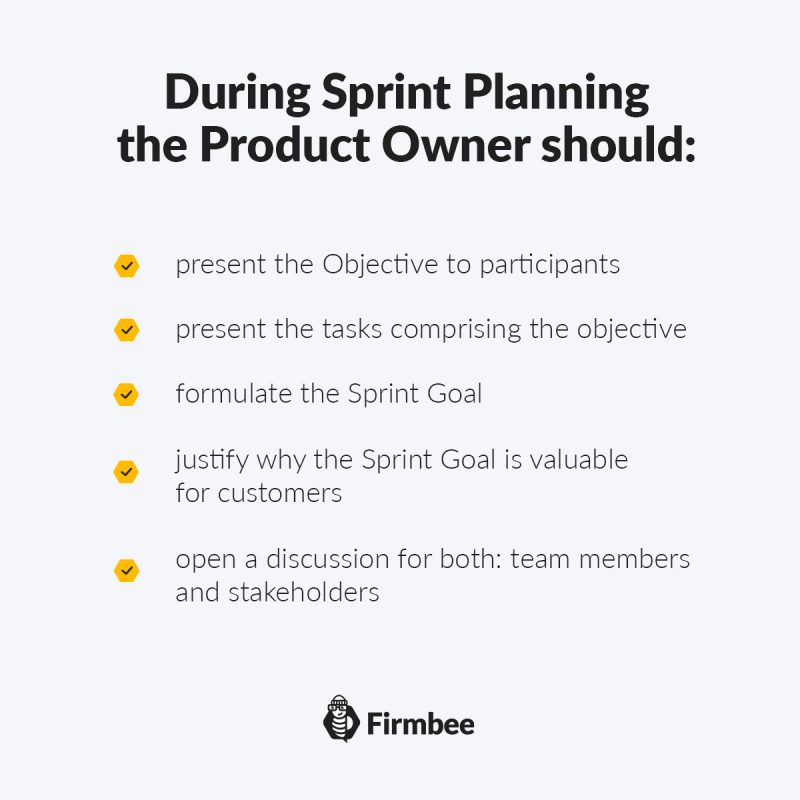Sprint Planning starts each Sprint. With Sprints lasting a month, this event takes a maximum of eight hours. If the Sprints are shorter, the Sprint Planning also shortens proportionally. The entire Scrum Team attends the event inviting Stakeholders or specialists from other teams. We will discuss the detailed course of Sprint Planning and the problems that may accompany the planning of work in a new Sprint in the following text.
Sprint Planning – table of contents:
- Introduction
- What is the new Sprint Goal?
- What is on the agenda?
- How will the do team do it?
- The results of Sprint Planning
- Summary
Introduction
Sprint Planning is one of the Scrum Events that we wrote about in a separate article. This event centers around the User Stories placed at the very top of the Product Backlog. In other words, on those that are most detailed.
Let’s take a closer look at the answers to the questions we’ve just put forth.
What is the new Sprint Goal?
The role of the Product Owner during Sprint Planning is to present the Goal and the tasks comprising it to the meeting participants.
The Product Owner starts the meeting by formulating the Sprint Goal and justifying why it is valuable from the customer’s point of view. Then opens a discussion in which not only Scrum Team members, but also Stakeholders can voice their opinion.
To sum up, the Product Owner gives the final wording of the Sprint Goal that the entire Scrum Team will strive to achieve and makes sure that the Goal is understood by all stakeholders.

What is on the agenda?
The second part of Sprint Planning focuses on selecting the User Stories to implement in the new Sprint and discussing how to make them more specific.
One of the most difficult tasks during Sprint Planning is to accurately estimate the number and labor intensity of the tasks selected for execution. The more experienced the Scrum Team, the more accurate it can estimate how much work can be done in a single Sprint. This is because the Team is applying effective estimation techniques, which we wrote about in detail in previous articles and here. Many Scrum Teams know and utilize methods to speed up the maturation of the Team as well as make the process easier and more standardized. These techniques include primarily Planning Poker and Team Estimation games.
How will the do team do it?
The third and most technical part of Sprint Planning focuses on answering the question “How will the team do it?”. In it, the Development Team proposes ways to accomplish the tasks selected for implementation in the second part of the meeting. No one but the Developers themselves should dictate how the tasks should be executed from the technical side.
Planning should take into account not only the execution technology but also the workflow between Developers. This will avoid stagnant work [bottlenecks], which can cause delays in the execution of tasks. As in the case of how to execute tasks, the distribution of tasks among individual Developers is also decided by them alone without external interference.
Typically, the Development Team here focuses on dividing User Stories into smaller tasks. The optimal length of task execution is one working day.

The results of Sprint Planning
The result of Sprint Planning is an unambiguous Sprint Goal, as well as detailed User Stories selected for execution from the Product Backlog. All these elements make up the Sprint Backlog, which we have devoted a separate article to.
Summary
Sprint Planning is the Scrum event that starts each Sprint. The Scrum Team can invite Stakeholders and external experts to it.
During Sprint Planning, the Goal of the new Sprint is defined. The Development Team determines with the Product Owner what to do and decides how to accomplish the planned tasks.
The result of Sprint Planning is the Sprint Backlog, which the Developers use to select daily tasks from the queue for execution.
If you like our content, join our busy bees community on Facebook, Twitter, LinkedIn, Instagram, YouTube, Pinterest.
Author: Caroline Becker
As a Project Manager, Caroline is an expert in finding new methods to design the best workflows and optimize processes. Her organizational skills and ability to work under time pressure make her the best person to turn complicated projects into reality.
Scrum Guide:
- Glossary of basic terms, roles and notions
- What is Scrum?
- Scrum values
- How to implement Scrum in your company?
- Scrum Team - what is it and how does it work?
- Who is a Product Owner?
- The most common mistakes of Product Owner
- Who is the Scrum Master?
- Characteristics of a good Scrum Master
- The most common mistakes of Scrum Master
- What statistics and metrics should the Scrum Master track?
- Cooperation between Product Owner and Scrum Master
- Development Team in Scrum
- The most common mistakes of Developers
- Scrum artifacts
- Scaling Scrum
- Sprint Backlog
- What is the Product Backlog?
- What are User Stories?
- Creating the best User Story with INVEST
- The most common User Story mistakes
- User Story Acceptance Criteria
- Estimation and Story Points in Scrum
- Planning Poker
- Team Estimation Game
- Defining Increment
- Scrum events
- What is Sprint in Scrum?
- Scrum Team Commitments - Product Goal, Sprint Goal and Definition of Completion
- What is a Burndown Chart?
- How to create and interpret a burndown chart?
- Advantages and disadvantages of the burndown chart
- Kanban boards in Scrum and Scrumban
- Velocity in Scrum - Speed of the Development Team
- Daily Scrum
- Sprint Planning
- Sprint Review
- What is a Sprint Retrospective?
- Common mistakes during a Sprint Retrospective
- Product Backlog nurturing


















